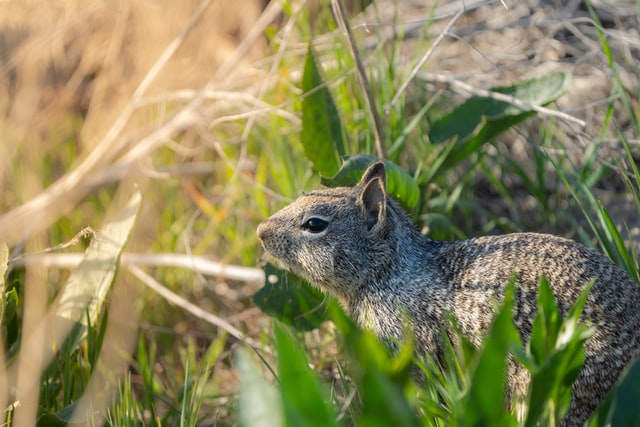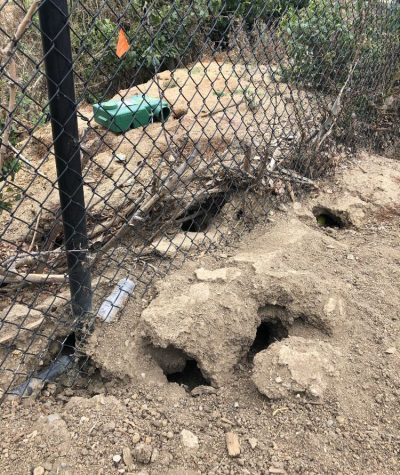Getting Rid Of Ground Squirrels

Getting rid of ground squirrels can be difficult if you do not understand the specifics of their behavior so let’s learn more!
When we are young, squirrels can seem like just another fuzzy creature scampering around the neighborhood. Some of us may have even enjoyed watching their acrobatics, or their frantic interactions with one another as they defy gravity while scaling the trees in our yards.
As we get older though we come to realize that certain squirrels can be a nuisance, cause damage to our property, and even become harmful carriers of disease and parasites.
The California Ground Squirrel, named so because they are burrowing creatures who den underground, can cause expensive damage to property, irrigation systems, and gardens.
What are Ground Squirrels?
Ground Squirrels are a specific species (Otospermophius beecheyi) of squirrel that live, breed, and horde their food in underground burrows, hence the name “Ground Squirrel”. They are found all over North America and are the most common vertebrate pest in agricultural, urban and residential areas.
Ground Squirrels live in colonies. A Ground Squirrel colony can be as small as 2 individuals with the possibility of growing to 20 or more depending on the amount of food and water available in a given area.
How to identify ground squirrels
At first glance it may seem hard to distinguish Ground Squirrels from Tree Squirrels but we have compiled a simple list of what to look for that will give you a discerning eye.
- Ground Squirrels are 14 to 20 inches in length
- Ground Squirrels have mottled brown/gray/white fur
- Ground Squirrels forage above ground, near their burrows. This means whenever they are scared, instead of running for high ground such as trees or up telephone poles they will head toward their burrows.
For more information on Ground Squirrel identification and how to tell them apart from Tree Squirrels check out our Got Gopher Blog Page.
What does a ground squirrel burrow look like?
Ground squirrel burrows are typically 4 inches in diameter, though older well traveled burrow entrances can grow over time. A Ground Squirrel burrow can reach lengths of up to 30 ft. at a maximum depth of 6 ft. below the surface. Burrows can be identified by several entrances within a 15 sq ft. area. Burrows provide a safe place for Ground Squirrels to mate, store food, rear their young, and hibernate. They often dig their burrows along ditches, against fencelines (pictured to the right), along the edges and within agricultural lands.

Damage Caused By Ground Squirrels
Ground Squirrels are the cause of major damage in California and all over the United States.
Agricultural Damage caused by Ground Squirrels
Ground Squirrels cause the most damage to agricultural properties when they are adjacent to un-cultivated land where their populations are not controlled.
- Ground Squirrels, though burrowing creatures, still have all the skills of their tree dwelling counterparts. They can climb trees and eat their fruits and nuts from set to maturity and all throughout harvest as well.
- During harvest seasons Ground Squirrels typically begin hording seeds and nuts for winter. This is when the damage to crops will explode because they are collecting food for storage as well as consuming for sustenance.
- Ground squirrels will also forage on vegetative crops such as lettuce, alfalfa, cole crops, and berries.
- Ground Squirrels will gnaw on everything and anything. From plastic irrigation lines, plastic pieces of sprinkler systems to tree roots, these critters can cause untold destruction to equipment. The gnawing of tree roots will also leave your crops and orchards open to fungal infection and tree death.
Residential and Urban Damage caused by Ground Squirrels
One of the miracles of living in a modern civilization is how well we have controlled the distribution of water. In our cities and neighborhoods, we have access to water for drinking, sewage removal, and watering our gardens and lawns.
We humans are not the only ones who benefit from this modern miracle of engineering.
Ground squirrels love residential and urban areas because of how well irrigated the soil is, making it much easier to burrow than hard packed dry soil in the less irrigated areas of the wild that would normally be their habitats.
This brings them to our cities and homes in droves where they cause all types of damage:
- Foraging Damage: Ground Squirrels will damage food-bearing and ornamental plants through feeding and and hording.
- Burrowing: Ironically, the burrowing of ground squirrels can cause the soil to erode and dry out, ruining the ability for the soil to provide nutrients to plants and trees.
- Mound and Rock Hazards: When burrowing Ground Squirrels tend to push out unwanted stones and soil into mounds on the surface. This burrow refuse causes tripping hazards for pedestrians and animals, make it difficult for the use of landscape machinery as well as being generally unsightly.
- Gnawing Damage: Ground Squirrels will gnaw on tree bark (an act known as girdling that can actually kill trees), tree roots, on plastic garden irrigation and sprinkler systems, underground wiring, and plastic siding on sheds, decks, and homes.
- Carriers of Disease: The greatest threat that these critters cause towards humans directly is the carrying of deadly diseases, especially when a ground squirrel population grows out of control.
Plague warning: As recent as 2020, a case of Bubonic Plague was found in a Ground Squirrel in Colorado well as killing a young boy in Mongolia. It is never a good idea to handle dead animals without proper PPE. Even with proper PPE, a trained and licensed professional should always be called to deal with wild animal remains. If you find a grouping of dead Ground Squirrels on your property call animal control immediately as well as alerting the nearest wildlife authority.
Getting Rid Of Ground Squirrels
There are 3 conventional methods available to help you get rid of ground squirrels.
- Trapping : If the Ground Squirrel population is moderate then trapping is an excellent control solution. Live trapping is not recommended as it is illegal to relocate wildlife in the state of California without a permit. To avoid the issues that come with live-trapping there are several other types of traps available: box traps, tunnel traps, and conibear traps. Do not handle a dead squirrel without the proper PPE.
- Fumigation : Burrow fumigation can be an effective solution to a Ground Squirrel infestation when the circumstances allow. The best time to fumigate is in the spring when soil moisture is at its peak. This helps to contain and concentrate the fumes for maximum efficacy. Do not fumigate in the summer when the ground is dry and cracked as the fumes will escape. You should contact a professional for an assessment of your infestation as most counties have regulations on how fumigation can be performed. Fumigation also has the negative side effect of killing non-pest species if you are not careful.
- Baiting : Using toxic bait to control a Ground Squirrel population is also an option. Due to the toxic nature of the bait, tamper-proof bait boxes are necessary. There are also regulations as to how the baiting can be implemented such as vicinity to residential housing and the presence of non-pest species who may encounter the bait. This means consulting a pest control professional is the best way to implement this solution.
If you are experiencing a ground squirrel infestation or would like more information regarding, Got Gophers and our services, please contact us now so we can help you with all your pest control needs!
How to Effortlessly Trap Summer Gophers in the Bay Area
Gophers Don’t Take a Summer Break Because the Bay Area’s weather stays mild, gophers remain busy underground even in summer. Moreover, dry soil pushes them
Smells That Attract Raccoons…And How To Avoid Them
If you have raccoons on your property call Got Gophers now! Raccoons are intelligent and resourceful creatures that can be drawn to certain smells in
Safeguard Your Sanctuary: Expert Strategies for Removing Raccoons with Precision
Understanding the Need for Removing Raccoons Raccoons can be dangerous! Do not risk disease or physical injury, call our trained professionals now! Removing raccoons from
Effective Methods for Trapping Moles
Trapping moles can get messy, contact Got Gophers and let us handle the rest. Moles can wreak havoc on your garden, leaving behind a trail
